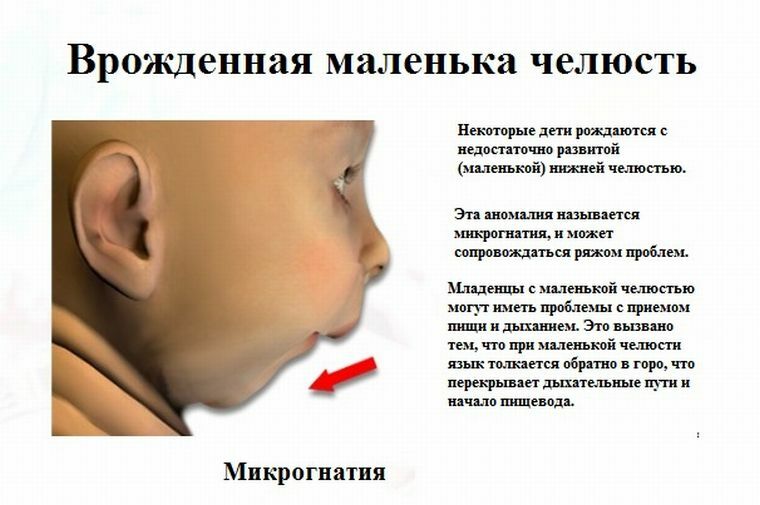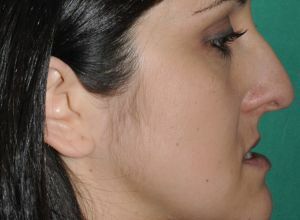 Micrognathia is characterized by insufficient development of the human jaw.
Micrognathia is characterized by insufficient development of the human jaw.
An abnormality can be upper when only the bones of the upper half of the jaw are affected, or the lower one( it is also called microgenia).
In rare cases, pathology is complex, in which there is underdevelopment of the lower and upper jaw simultaneously.
Contents
- Provoking factors
- Small jaw visible from afar
- Diagnosis of the disease
- Basic treatments for
- Possible consequences for ignoring the symptoms
Aggravating factors
The main reasons for the appearance of the dentoalveolar pathology are related to the following factors:
- abnormal fetal development during pregnancy;
- heredity;
- absence in the organism of the pregnant woman of the necessary microelements for the full development of the child's bones;
- large loss of teeth( adentia) at an early age, which were not replaced by prostheses;
- early loss of milk teeth due to concomitant disease;
- P. Robin syndrome, manifested in congenital disruption of the formation of the child's jaw;
- progeria, characteristic signs of which are also alopecia, insufficient growth of the patient's body, dystrophy;
- pathology of the endocrine system;
- respiratory problems that impede breathing;
- trauma to the face or congenital anomalies in the formation of the jaw;
- abuse of smoking and alcohol, drug addiction.

The small jaw is noticeable from afar
Micrognathia is one of those diseases that can be noticed during a primary examination of the patient due to significant changes in the oval of his face. Also, the pathology is manifested in a number of concomitant symptoms:
- malocclusion;
- occurrence of shortness of breath;
- micrognatia of the upper jaw leads to the fact that the patient has an upper lip;
- with the lower form of the anomaly, the same problem occurs with the lower lip, as well as insufficient development of the tongue( glossoptosis) and a cleft in the sky is formed.
Diagnosis of the disease
Anomaly is diagnosed already at the stage of intrauterine development of the child with the help of echography. The face of the fetus is scanned in the sagittal plane for better detection of pathology.
Another indication that an abnormality can be determined is the excessive amount of amniotic fluid. They do not penetrate the mouth of a developing baby due to incorrect formation of the jaw and tongue.
The basic methods of treatment
Treatment of an underdeveloped jaw is carried out both conservative methods, and by carrying out the operation.
In the first case, the orthodontist appoints: 
- special nipples to correct bite and normal nutrition;
- kapy and bracket system for the same purpose;
- sling for chin support;
- creation of dental crowns guiding the bite in the desired direction.
In addition to these, other orthodontic devices may also be used.
If necessary, an artificial bone growth can be applied to an abnormally developing half of the jaw. For this, a complex plastic surgery is carried out, presupposing complete anesthesia of the patient.
Surgical correction of occlusion is carried out according to the method of Semenchenko:
- The patient is dissected by the jaw, making a horizontal incision of the mucosa and breaking the periosteum in a fold on the left and right side of the alveolar process, with a view to subsequently pushing it forward.
- A perpendicular incision is made from the bridle of the upper lip until it intersects with the first one.
- With the help of a special tool, facial tissues are separated from the bones of the upper jaw, which is dissected with a circular saw.
- Having broken off the lower parts of the upper jaw, for which it is attached to the wing tips of the main bone, mechanically change the location of the jaw, pushing it forward to give the correct position.
- Then fixing the tire for 60 days, and the wound is sewed with a surgical thread. If necessary, this period is prolonged for some time.
As a result, the patient's bite is restored. The upper dentition is correctly placed on the lower dentition. Correction of the tongue sagging, breathing improves. After passing the rehabilitation period, the patient acquires the appearance of an absolutely healthy person.
Possible consequences if the symptoms are ignored
 This disease, like many other pathologies of the maxillofacial zone, is most easily amenable to correction in the initial stages of development.
This disease, like many other pathologies of the maxillofacial zone, is most easily amenable to correction in the initial stages of development.
If the symptoms are ignored for a long time, the abnormal changes will not be amenable to full correction and will require long-term treatment with purely surgical methods.
With all this, an incorrect bite and shortness of breath will respond to the entire body of the patient:
- will have gastrointestinal tract diseases;
- can develop cardiovascular pathologies;
- disorders of the CNS due to insufficient cerebral blood supply.
Micrognathia refers to serious jaw pathologies. This disease is mainly congenital in nature and significantly affects the quality of life of the patient and the general state of his health, but it is treatable, which is best done in the early detection of symptoms in the child.
Therapy involves both hardware methods and a fairly complex operation on the jaw. The disease itself belongs to the competence of orthodontists.
